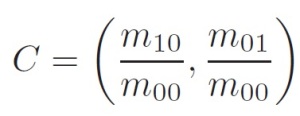A tutorial on binary descriptors – part 3 – The ORB descriptor
来源:互联网 发布:网络管理基础书籍 编辑:程序博客网 时间:2024/05/29 09:16
转载地址:https://gilscvblog.com/2013/10/04/a-tutorial-on-binary-descriptors-part-3-the-orb-descriptor/
Gil's CV blog
A tutorial on binary descriptors – part 3 – The ORB descriptor
This third post in our series about binary descriptors that will talk about the ORB descriptor [1]. We had an introduction to patch descriptors, an introduction to binary descriptors and a post about the BRIEF [2] descriptor.
We’ll start by showing the following figure that shows an example of using ORB to match between real world images with viewpoint change. Green lines are valid matches, red circles indicate unmatched points.

ORB descriptor – An example of keypoints matching using ORB
Now, as you may recall from the previous posts, a binary descriptor is composed out of three parts:
- A sampling pattern: where to sample points in the region around the descriptor.
- Orientation compensation: some mechanism to measure the orientation of the keypoint and rotate it to compensate for rotation changes.
- Sampling pairs: the pairs to compare when building the final descriptor.
Recall that to build the binary string representing a region around a keypoint we need to Go over all the pairs and for each pair (p1, p2) – if the intensity at point p1 is greater than the intensity at point p2, we write 1 in the binary string and 0 otherwise.
The ORB descriptor is a bit similar to BRIEF. It doesn’t have an elaborate sampling pattern as BRISK [3] or FREAK [4]. However, there are two main differences between ORB and BRIEF:
- ORB uses an orientation compensation mechanism, making it rotation invariant.
- ORB learns the optimal sampling pairs, whereas BRIEF uses randomly chosen sampling pairs.
Orientation Compensation
ORB uses a simple measure of corner orientation – the intensity centroid [5]. First, the moments of a patch are defined as:

ORB descriptor-Patch’s moments definition
With these moments we can find the centroid, the “center of mass” of the patch as:

ORB descriptor – Center of mass of the patch
We can construct a vector from the corner’s center O, to the centroid -OC. The orientation of the patch is then given by:

ORB descriptor – Orientation of the patch
Here is an illustration to help explain the method:

ORB descriptor – Angle calculation illustration
Once we’ve calculated the orientation of the patch, we can rotate it to a canonical rotation and then compute the descriptor, thus obtaining some rotation invariance.
我理解一个keypoint周围的patch,应该是以keypoint为中心,的某一个形状。
<1> 在ORB中用灰度质心法求keypoint的方向时,公式里的坐标问题:
第一种理解:以keypoint为坐标原点(0,0),坐标轴与图像u-o-v坐标轴同向,建立一个局部坐标系。公式里的每个点坐标是在这个坐标系下的坐标,这样求得质心C(cx,cy)的坐标后,与keypoint O的连线,这个连线与 “ 以keypoint为坐标原点的坐标系” 的X轴的夹角,刚好就是质心C的 arctan(cx,cy)。
第二种理解:公式里的每个点的坐标是在图像坐标系下的,即u-o-v坐标系下的。假设keypoint的坐标为 O(OX,OY),当用灰度质心法求得这个patch的质心 C(CX, CY), OC的连线与u轴的夹角为 arctan(CX-OX, CY-OY)。 当图像的灰度确定后,patch的质心位置是确定的,是哪个像素点就是哪个像素点,与在哪个坐标系下计算的无关。所以: keypoint的方向 arctan(cx,cy)=arctan(CX-OX, CY-OY),因为几何上:cx=CX-OX,cy=CY-OY
<2>ORB 描述子对旋转无关的理解
在光照不变的条件下:当特征点被旋转一个角度 theta后, 特征的方向也被旋转了相应的theta。这就启示我们:如果每一时刻在取patch时的坐标轴与
特征方向之间的关系是固定不变的,这样当特征点发生旋转时,取的两个patch的像素是完全一样的,两个描述子描述的区域是一样的。
假设在取patch时,先以keypoint为坐标原点(0,0),坐标轴与图像u-o-v坐标轴同向,取得一个patch S。再对 S进行旋转R(theta),theta为特征的方向,得到一个新的patch S' , 这个 S’ 是在以keypoint为坐标原点(0,0),x轴与特征的方向同向,y轴与x轴垂直的坐标系下取得的。这样不管特征点怎么旋转,相同特征点的描述子的patch 是同一个区域。即Orientation compensation 的含义。
<3>首先,ORB利用FAST特征点检测的方法来检测特征点,然后利用Harris角点的度量方法,用极大值抑制法,从FAST特征点中挑选出Harris角点响应值最大的
Learning the sampling pairs
There are two properties we would like our sampling pairs to have.One is uncorrelation – we would like that the sampling pairs will be uncorrelated so that each new pair will bring new information to the descriptor, thus maximizing the amount of information the descriptor carries.The other is high variance of the pairs – high variance makes a feature more discriminative, since it responds differently to inputs.
这一段的思想在这篇中文博客的解释 http://www.cnblogs.com/ronny/p/4083537.html:
ORB使用了一种学习的方法来选择一个较小的点对集合。方法如下:
首先建立一个大约300k关键点的测试集,这些关键点来自于PASCAL2006集中的图像。
对于这300k个关键点中的每一个特征点,考虑它的
那么当300k个关键点全部进行上面的提取之后,我们就得到了一个
对该矩阵的每个列向量,也就是每个pair在300k个特征点上的测试结果,计算其均值。把所有的列向量按均值进行重新排序。排好后,组成了一个向量
进行贪婪搜索:从
The authors of ORB suggest learning the sampling pairs to ensure they have these two properties. A simple calculation [1] shows that there are about 205,000 possible tests (sampling pairs) to consider. From that vast amount of tests, only 256 tests will be chosen.
The learning is done as follows. First, they set a training set of about 300,000 keypoints drawn from the PASCAL 2006 dataset [6].Next, we apply the following greedy algorithm:
- Run each test against all training patches.
- Order the tests by their distance from a mean of 0.5, forming the vector T.
- Greedy search:
- Put the first test into the result vector R and remove it from T.
- Take the next test from T, and compare it against all tests in R. If its absolute correlation is greater than a threshold, discard it; else, add it to R.
- Repeat the previous step until there are 256 tests in R. If there are fewer than 256, raise the threshold and try again.
Once this algorithm terminates, we obtain a set of 256 relatively uncorrelated tests with high variance.
To conclude, ORB is binary descriptor that is similar to BRIEF, with the added advantages of rotation invariance and learned sampling pairs. You’re probably asking yourself, how does ORB perform in comparison to BRIEF? Well, in non-geometric transformation (those that are image capture dependent and do not rely on the viewpoint, such as blur, JPEG compression, exposure and illumination) BRIEF actually outperforms ORB. In affine transformation, BRIEF perform poorly under large rotation or scale change as it’s not designed to handle such changes. In perspective transformations, which are the result of view-point change, BRIEF surprisingly slightly outperforms ORB. For further details, refer to [7] or wait for the last post in this tutorial which will give a performance evaluation of the binary descriptors.
The next post will talk about BRISK [3] that was actually presented in the same conference as ORB. It presents some difference from BRIEF and ORB by using a hand-crafted sampling pattern.
Gil.
References:
[1] Rublee, Ethan, et al. “ORB: an efficient alternative to SIFT or SURF.” Computer Vision (ICCV), 2011 IEEE International Conference on. IEEE, 2011.
[2] Calonder, Michael, et al. “Brief: Binary robust independent elementary features.” Computer Vision–ECCV 2010. Springer Berlin Heidelberg, 2010. 778-792.
[3] Leutenegger, Stefan, Margarita Chli, and Roland Y. Siegwart. “BRISK: Binary robust invariant scalable keypoints.” Computer Vision (ICCV), 2011 IEEE International Conference on. IEEE, 2011.
[4] Alahi, Alexandre, Raphael Ortiz, and Pierre Vandergheynst. “Freak: Fast retina keypoint.” Computer Vision and Pattern Recognition (CVPR), 2012 IEEE Conference on. IEEE, 2012.
[5] Rosin, Paul L. “Measuring corner properties.” Computer Vision and Image Understanding 73.2 (1999): 291-307.
[6] M. Everingham. The PASCAL Visual Object Classes Challenge 2006 (VOC2006) Results.http://pascallin.ecs.soton.ac.uk/challenges/VOC/databases.html.
[7] Heinly, Jared, Enrique Dunn, and Jan-Michael Frahm. “Comparative evaluation of binary features.” Computer Vision–ECCV 2012. Springer Berlin Heidelberg, 2012. 759-773.
- A tutorial on binary descriptors – part 3 – The ORB descriptor
- Tutorial on Binary Descriptors – part 1
- A Tutorial on the SWEEP Operator–读书笔记
- A Tutorial on the Device Tree
- ReactiveCocoa Tutorial – The Definitive Introduction: Part 1/2
- ReactiveCocoa Tutorial – The Definitive Introduction: Part 1/2
- ReactiveCocoa Tutorial – The Definitive Introduction: Part 2/2
- ReactiveCocoa Tutorial – The Definitive Introduction: Part 1/2
- ReactiveCocoa Tutorial – The Definitive Introduction: Part 2/2
- Groovy Tutorial for Java Developers – Part 1: The Basics
- Changing a process’ file descriptor on the fly
- iPhone JSON Flickr Tutorial – Part 3
- iPhone JSON Flickr Tutorial – Part 3
- Debug Tutorial Part 3: The Heap
- Bag-of-Features Descriptor on SIFT ORB SURF (BoF-SIFT)
- The Java(TM) Tutorial: A Short Course on the Basics (3rd Edition)
- binary-descriptors
- OpenGL ES Tutorial for Android – Part V – More on Meshes
- MySQL中group_concat函数深入理解
- Coderforces Chat room
- 简单句的五大句型
- 【机器学习】python第三方模块lda包调用代码
- TensorFlow 学习资源
- A tutorial on binary descriptors – part 3 – The ORB descriptor
- 字符流解析 储存
- 开篇立论-记在it之前
- 自学qt之临时文件临时目录 listWidget QStringList 打包程序 qml
- sax解析实现xml增删改
- MTCNN解读:Joint Face Detection and Alignment using Multi-task Cascaded Convolutional Networks
- scala开发环境
- Eclipse中为什么创建DynamicWebProject后没有默认的web.xml文件?
- 中文转码



